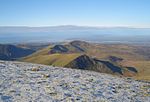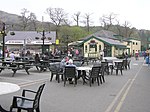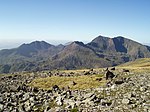Snowdon Mountain Railway

The Snowdon Mountain Railway (SMR; Welsh: Rheilffordd yr Wyddfa) is a narrow gauge rack and pinion mountain railway in Gwynedd, north-west Wales. It is a tourist railway that travels for 4.7 miles (7.6 km) from Llanberis to the summit of Snowdon, the highest peak in Wales.The SMR is the only public rack and pinion railway in the United Kingdom, and after more than 100 years of operation it remains a popular tourist attraction, carrying more than 140,000 passengers annually. The line is owned and operated by Heritage Great Britain, operators of several other tourist attractions in the United Kingdom. The railway is operated in some of the harshest weather conditions in Britain, with services curtailed from reaching the summit in bad weather and remaining closed during the winter from November to mid-March. Single carriage trains are pushed up the mountain by either steam locomotives or diesel locomotives. It has also previously used diesel railcars as multiple units. The traditional logo for the railway includes a pinion ring engaged on a rack bar, representing the rack railway technology used by the line.
Excerpt from the Wikipedia article Snowdon Mountain Railway (License: CC BY-SA 3.0, Authors, Images).Snowdon Mountain Railway
Llanberis Path,
Geographical coordinates (GPS) Address Nearby Places Show on map
Geographical coordinates (GPS)
| Latitude | Longitude |
|---|---|
| N 53.0998 ° | E -4.1045 ° |
Address
Llanberis Path
Llanberis Path
LL55 4UL , Llanberis
Wales, United Kingdom
Open on Google Maps











